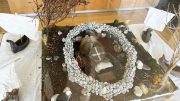United Kingdom import Mary-Anne Collis is keen on bats.
“When I heard about white nose syndrome I was extremely interested and wanted to be part of helping to find out all the intricacies of it and assisting with saving the hibernating bat populations being affected,” said Collis.
Collis began her PhD studies in January of 2013 under supervisor and University of Winnipeg associate professor of biology Craig Willis, joining a team of U of W graduate students in the Willis Bat Lab (WBL). Because the U of W lacks a doctoral program in the biological sciences, however, Collis enrolled in the U of M’s biological science department, carrying out the majority of her research at the U of W.
As with many others in the WBL, Collis’ research concerns the pathogenic fungal disease known as “white nose syndrome” (WNS)—so called for the crusted white infection that forms over the muzzles, wings, and ears of bats—that is currently decimating select North American bat species populations.
The infection disturbs and wakes bats from hibernation, resulting in a premature decrease in their fat stores in the winter.
“Some then try and emerge early—presumably in search of food—and die from the cold and starvation,” said Collis.
In 2006, a group of researchers visited a cave-dwelling population of hibernating bats near Albany, New York only to find the majority of the colony had succumbed to the then unknown WNS. In the short time since the initial outbreak, the disease has spread like a bat out of hell, and the USGS National Wildlife Health Centre estimates an 80 per cent loss in total northeastern U.S. bat numbers.
The little brown bat (Myotis lucifugus) and northern long-eared (Myotis septentrionalis) bat are the focal species of Collis’ research; the former species the most commonly found and severely affected by WNS on the continent.
“[The little brown bat population] has seen hibernating population losses of 75-100 per cent over one winter and has just been recommended for federally endangered status in Canada,” said Collis.
“It is now also on the Species at Risk list in Ontario. The northern long-eared is of a similar status in Canada and Ontario but a lot less is known about this species as it is a lot less common,” Collis added.
WBL researchers like Collis worry it is only a matter of time before the disease makes an appearance in the resident populations of their Manitoba and northwestern Ontario study zones. Recent confirmed accounts of WNS along the border of Ontario and Minnesota do nothing to alleviate these worries.
“My project is using a study area right on the very edge of where WNS is present,” said Collis. “At the moment none of the sites are affected, but the disease is approximately 300 kilometres from our sites and we know that bats can move large distances throughout the year, sometimes up to 500 kilometres – moving between summer roosting sites (for females) and hibernation sites.”
Little is known about the little brown bat’s survival strategies generally speaking, rendering the whole business of understanding and resolving WNS the more complex. Collis is hoping to help fill the information gap with her research by getting ahead of the spread, focusing on areas that have not yet been ravaged by WNS in hopes of gathering baseline data for unaffected populations.
“My project aims to look at populations that are ‘healthy’ and determine what those populations do; and their survival rate over a few years; and how they cope with different cave/mine types over hibernation; and whether some are better than others and why,” said Collis.
“With the system we are using, we can also look at how much individuals move between different sites to see how the fungus could be transported between sites. The idea is to look at normal populations right on the frontline of the disease, [so that] when the disease comes through we will be able to determine if some individuals survive better than others and why, as well as how [WNS] is moving across the landscape.”
Collis and members of the WBL trap their winged subjects using delicately stringed harp traps that ensnare and funnel the bats into pouches. Tissue samples and swabs are taken (to test for WNS), as are general measurements of weight, sex, and forearm length. Thereafter, bats are implanted with solar powered passive integrated transponder (PIT) microchips unique to each individual, allowing the team to track their dispersal and general whereabouts overtime.
“With this it means that we know exactly when our marked bats are going in and out of hibernation and we already know their sex and can look up their age. This in conjunction with monitoring conditions both in and out of the hibernacula through the course of a year will help us to understand how and when they are moving around.”
Collis is also investigating the effects of temperature, humidity, and barometric pressure on hibernacula emergence timing.
In an attempt to utilize the community in helping members of the Willis Bat Lab locate roosts around the city, the lab began a program called Manitoba Bat Blitz (MBB). The purpose of the MBB is to encourage the public to report known locations of bats residing on their property and to alert the public to some of the telltale behavioural signs of WNS — namely, premature emergence from hibernation.
Know the whereabouts of some bats? Interested in participating as a volunteer with Manitoba Bat Blitz? Email mbbatblitz@hotmail.com or call (204) 789-1463.
This article was originally published in the Gradzette.




